Hop Press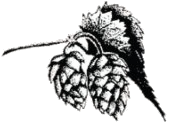
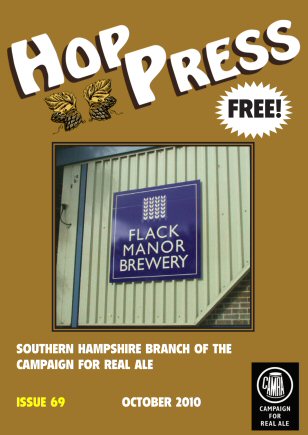
Issue 69 – October 2010
Go to Previous Hop Press Browse for another Hop Press
Go to Next Hop Press
Contents
- Editorial
- Brewing Returns to Romsey
- Pub News
- Champions’ League
- LocAle – What’s it all about?
- Competition Crossword
- Woolston Beer Festival
- Walking and Drinking (11)
- Hillary Jazuk
2010 looks to be shaping up as another record breaking year for the brewing trade but for no reasons that we can celebrate. It became the first year ever that the sale of beer in the off-sale market (predominantly supermarkets) exceeded that in pubs. And this is in a year when total sales continued to decline – 14% in total over the past six years but a staggering 31% in the country’s pubs. With the average pub price for a standard lager currently £2.81 and some supermarket offers equivalent to little more than a 70p pint, reasons are not hard to find.
Despite these dismal figures and their obvious impact on pub closures, which continue to run at scores per week, the new Coalition Government seem to be confused as to any action. Before the election Cameron was extolling his ill-defined ‘big society’ with the specific role-model example of community run pubs; now within months of coming to power a fund (a paltry £3.3m), specifically set up to help communities buy their local pubs and administered by the non-profit making Plunkett Foundation, has been summarily axed and is to be ‘replaced with an advice leaflet.’
This announcement, at the end of August, has been given added significance by a report in mid-September by the British Beer and Pub Association (BBPA) that drew attention to the 893 rural pubs closing in the last year (more than twice the rate of closure of village shops, already spoken of as a crisis). BBPA executive Brigid Simmonds emphasised that village pubs are far more than just social centres, they bind together the community fabric of the village in exactly the way that the Coalition claims it wants to see.
Government spokesman, Local Government Minister Bob Neill’s, pathetic response was that “…the new government had already axed cider tax and was stopping below-cost sales of alcohol by supermarkets.”
In its seemingly mindless rush to tear down the whole fabric of our way of life, the Government has also instituted a ‘review’ of the 2003 Licensing Act with the declared (but again ill-defined) intention of ‘rebalancing’ it. For this major exercise it allocated just a ludicrous six week consultation period! Although the 2003 Act took several years to draft and has not even been in force long enough to see any long-term results or trends, this Government is proposing radical changes that could, in some instances, take us back to days even before the previous law. Some of the wilder proposals include:
- Allowing local authorities to set a uniform closing time throughout their area – with the prospect of going back to the old 10.30 ‘time.’
- Where later hours are allowed, introducing a levy on all such premises.
- Drastically increasing the licensing fees (even though the 2003 Act already put them up, in many cases, by ten-fold).
- Severely restricting the right to appeal licensing decisions, and in effect putting appeals back into the hands of the local authority itself.
There are suggestions that could be beneficial to the community pubs that CAMRA particularly supports, especially a proposal to allow more community involvement in licensing decisions and the measures to combat cut-price alcohol sales. The general tenor of the Government’s initial response is, however, more of establishing punishments for possibly wayward premises rather than rewarding and encouraging those that are being well run and are adding to community cohesion.
It is expected that the concrete proposals will be incorporated in a Police Reform and Social Responsibility Bill due to be published and debated later in the year.
Last month saw the publication of the 2011 edition of CAMRA’s flagship work, the Good Beer Guide. This thirty-eighth edition continues the story of recent years – the astonishing growth of small craft breweries. There are 767 breweries listed, 78 more than last year. Roger Protz, the Guide’s editor said, on publication day:
“The real ale revolution goes on in spite of all the problems facing the brewing industry such as the often anti-competitive behaviour of the large pub companies, the heavy and continuing rise in tax on beer, grossly unfair competition from supermarkets, and the smoking ban in pubs. Yet, against all the odds, craft breweries continue to sprout like mushrooms at dawn.”
“The main reason is a simple one: craft brewers are responding to genuine consumer demand. Beer in pubs may be expensive compared to cheap supermarkets but drinkers are prepared to pay a bit extra for beer with taste and quality. Real ale hits the spot in every way: it has flavour and is made from pure, natural ingredients that are grown mainly here in Britain. More and more people want to think local and drink local and real ale meets that demand.”
One fantastic success story is the home-brew pub. When CAMRA was founded in 1971 there were just four pubs in England still brewing beer on their premises, all of them considered as quaint anachronisms surviving into a wrong century. The new guide now lists 136, and still includes the four survivors.
The Guide, whilst still a mine of printed information, has kept up with modern life styles and is now also available as an app for your mobile and as a POI file for your sat-nav. For more information on the mobile app: http://m.camra.org.uk or text CAMRA to 88080 and follow the response. For information and technical queries on the various sat-nav versions, please email: gbgpoi@camra.org.uk
Elsewhere in this issue there is a page devoted to the Woolston Beer Festival, taking place over the weekend of 8-9 October. Although a small festival in comparison with our annual Guildhall event it is a new venture for CAMRA’s Southern Hampshire Branch. As we go to press though, tickets have all but sold out. See https://www.woolstonbeerfestival.camra.org.uk/outlets.php for latest details.
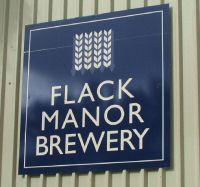
Brewing Returns to Romsey Hop Press index
Pat O'Neill
Do what one will, it is clearly impossible to stop someone brewing beer in Romsey! Strongs dominated the scene for more than two centuries (1778-1981) and on their closure by Whitbread (remember them?) the resulting vacuum was rapidly filled by the Hampshire Brewery, which had originally been set up in Andover but moved in 1998. Their tenure lasted ten years until closure in 2008 left the void again. Happily, this has now been filled by a brand new brewery that started production in late May. The brewery occupies unit 8 on the Greatbridge Road Industrial Estate, coincidentally the next building to that used by Hampshire.
The Flack Manor Brewery, is a 20-barrel operation – in other words it can produce 5760 pints (20 x 36gals x
8) in a single brewing cycle, which would occupy most of one day. It is the brainchild of Nigel Welsh, formerly a
director of the Ringwood Brewery before its takeover by the mega-brewer Marston. Just three people, Nigel, Terry
Baker and Ann Stantiford run the whole show, who between themselves have already amassed an impressive 64 years
of brewing experience.
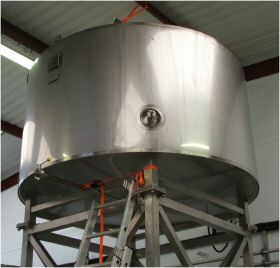
|
|
The ‘round’ |
The initial beer was designed as a 3.7%abv ‘session bitter,’ named Double Drop. It is a mid-amber beer with a good malt/hop balance and a hoppy finish. The beer uses malt from the brewer’s first choice of barley variety, Maris Otter, and the hops are Sovereign, a new ‘hedgerow’ variety similar to the classic Fuggles and Goldings. The flavour is without doubt that of a very traditional British bitter, as a brewing history buff might deduce from the name – double drop brewing was a method familiar to the Victorians but in recent years it has been rationalised out of use on cost and labour saving grounds – it uses an extra vessel and adds an extra process to the brewing operation. After mashing and boiling with the hops in the copper the wort is run off initially into a special shallow fermenter called the ‘round.’ The yeast is pitched and the beer-to-be undergoes an initial rapid fermentation for some 12 to 16 hours and is then run off – ‘dropped’ – into a normal fermenter for 5 or 6 days to come to completion.
The advantage claimed for this system is that the initial separation cleans up the wort eliminating dead yeast
cells and debris carried over from the copper, giving a cleaner more controlled charge for the proper
fermenters.
The equipment in the brewery is all newly built, much of it imported from Canada and supplied by the specialist brewery engineering design and build company, DME Brewing Services. Their bespoke designs have been successfully installed by many of Britain’s new small brewers – in the last decade DME have installed over 400 breweries worldwide, including in such unlikely locations as Kazakhstan, Beijing and even Palestine. From day one the plant has operated without a hitch, needing virtually no ‘debugging.’ One feature that was singled out as aiding quality control was the malt mill. All of the malt used is milled in house immediately before the mash, preserving freshness and allowing exact choice of grist coarseness.
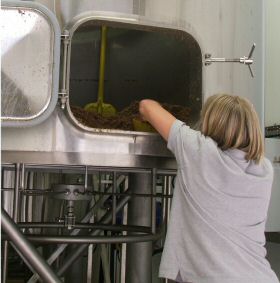
|
|
Ann clearing the mash tun of spent grains. |
The initial brew has been greeted with considerable success, a key measure being the re-order rate – it is easy for any new brewery to sell its first brew on novelty value alone, requests for subsequent repeat orders establish business success. For Double Drop repeat ordering has been running at a very healthy 95%. In fact this very success has to some extent created its own problems, delaying the introduction of a second beer to the brewery’s portfolio. The introduction of a second beer, almost certainly a mid-strength 4.2-4.5% abv best bitter, is now scheduled for early in the New Year and will very likely require installing another fermenter.
A slight diversion at this point into the realms of etymology. The brewery’s name has baffled many,
especially perhaps those who pride themselves on their knowledge of Hampshire history, since there is not any
ancestral pile of Flack Manor nor any antique, ennobled family of Flacks. Both WWII and the American cavalier
attitude to spelling were responsible. During the European conflict the south of England was home to a large
number of American airmen who daily took their Flying Fortress B17s over Germany, encountering intense
anti-aircraft fire, flak – from the German fliegerabwherkanone – during their sorties.
Hampshire was one area used for ‘rest and recreation’ for the stressed crews in what then came to be
(confusingly) called ‘flack shacks.’

|
| Beer storage vessels |
Although already operating retail sales at the brewery – draught beer can be bought in volumes from 4½ pints upwards – the New Year will also see the creation of a full shop, which we believe will be properly spelt as the Flak Shack, in part of the unit.
Currently, the area served by the brewery is not over extensive. With just three people to share all the tasks,
simply delivering the beer makes big inroads in the workforce. A 30-40 mile radius covers most deliveries with
the farthest flung being near Warminster. The brewery meshes in well with the CAMRA’s Locale principles,
described elsewhere in this edition of Hop Press.
Rob Whatley
Winchester
Over the last few years Hop Press has told readers about the various incarnations of the pub on the corner of North Walls and Parchment Street. It seemed that in every other edition of Pub News we would be reporting a change of management and a new name. Last year Jayne Gillin took over the pub and named it the Corner House. The pub is still going strong and Jayne is now to reopen the Green Man in Southgate Street. The Green Man had been closed for many months and will become ‘a lounge bar aimed at the over-35 market.’ Jayne, who was previously a director of a pub chain, also runs the St James Tavern in Romsey Road.
Further up the hill, the County Arms has been named as one of the best eight community pubs in the UK. Licensees Iain and Stephanie Read will now go forward to the national final of the Great British Pub Awards.
In a previous edition of Hop Press we reported on criticism of the Wykeham Arms. New manager Jon Howard took over the pub last October and has now overseen a £400,000 facelift for the well known hostelry. There is new signage, extra seating and the 14 guest bedrooms have been refurbished. The pub was closed for two weeks in August while the work was carried out. Also closing for refurbishment was the Jolly Farmer. In addition to a revamp of the restaurant and bar areas, a new kitchen has been installed. Managers Pat and Eddie Britton had complained earlier this year when Andover Road, on which the pub sits, was closed for weeks as work was carried out on a railway bridge, leading to a loss of passing trade. Ironically, the Greene King pub closed for its refurbishment just as the road reopened. We noted in the last edition that pubs in Winchester were hosting a variety of events to attract new customers. The Roebuck has announced a series of dinner events with speakers, the first of whom is former England footballer Phil Neal.
Bighton
Not to be outdone, the Three Horseshoes in Bighton hosted poet Elvis McGonagall in June as part of the ‘Poet in the Pub’ scheme run by Hampshire County Council.
Alresford
A staple attraction for many pubs, the weekly quiz, was lost when Sarah Stamper took over the Alresford’s Horse and Groom earlier in the year. The quiz has now been reintroduced by new licensees Phil Cripps and Shelley Burns. There is also a new menu from the refurbished kitchen.
Shawford
Also with a new menu is the Bridge at Shawford. The pub is part of the small Pub and Kitchen group and underwent a major refurbishment in May.
Compton
Nearby in Compton, after many delays, plans to build a 65 bed care home on the site of the Captain Barnard have finally been approved.
New Cheriton
A less dramatic loss occurred at the Hinton Arms in New Cheriton when thieves took the 30 hanging baskets that were decorating the pub, which lies on the A272. Owner Roger Mattia had spent around £4,000 on the impressive displays.
Braishfield
Fortunately the flower displays remained intact at the Dog and Crook in Braishfield, which enabled licensees Miriam Bevan and Alan Arthur to pick up first prize in the pub section of this year’s ‘Test Valley in Bloom’ competition. In June we bid farewell to Peter and Jenny Jones, who ran the Wheatsheaf for many years and built up a reputation for locally produced food, including that sourced from their own herd of pigs. After being closed all summer the pub finally reopened in September. New licensee is Matt Meadus, formerly manager at Hamble’s Royal Sovereign Yacht Club, in partnership with Simon, chef at the Peat Spade in Longstock. Beers on in an early visit were from Flack Manor, Itchen Valley, Marstons and Timothy Taylor.
Romsey
The Star in the Horsefair, closed somewhat suddenly in early July without explanation and there has been, as yet, no signs of activity at the pub.
Eastleigh
Earlier this year Fusion bar and grill opened on the ground floor of the former Martines nightclub. There were plans to open a nightclub in August but now the premises have again closed. Meanwhile, in the Swan Centre the Break and Loft Bar opened during the summer. It operates mainly as a restaurant during the day but the Loft Bar comes into its own in the evenings.
In Leigh Road, the mock-Tudor Leigh Hotel is for sale, freehold, at £400,000 and advertised as ‘suitable for development / conversion.’ In the High Street the old 101 Bar, closed for longer than most can remember, has work taking place and is advertising for staff to run a new wine bar.
Bishopstoke
Plans to construct four houses and six flats on the site of the Longmead Arms in Bishopstoke were rejected by Eastleigh planners in June but the decision is now the subject of an appeal. The pub is currently boarded up.
Netley
After many months of uncertainty the Station Hotel in Netley has been flattened and work is underway to construct 14 houses on the site.
Sway
Still standing, but with an uncertain future, is the Forest Heath in Sway. The grade II listed building is surrounded by hoardings which are adorned by forest scenes that were painted by local schoolchildren, volunteer groups and Brockenhurst College students. No plans have been submitted as yet and the owner of the building, David Stevenson, said in July that he had not decided on his plans for the site. Local campaigners are keeping a watchful eye on developments.
Totton
At least the fabric of the Forest Heath is still largely intact, unlike that of another well know Forest pub, the Red Lion in Totton. The licensee was due to leave the pub in late July and advertised a leaving party through a social networking site. The story was also picked up in the local press. Police then issued a temporary closure order citing ‘serious concern for public safety.’ Subsequently the district council’s licensing sub-committee agreed that the pub could reopen under a new licensee, although no alcohol could be sold after 11pm and no entertainment licence would be issued. During these events there were rumours that the site would be sold for housing but these have been denied by some of the potential developers. The pub remained closed and Paul Gill, regional manager of owners Enterprise Inns, said, “We’re looking at various options and no decision has been made.” The future of the pub is now even more in doubt as at the end of August there was a fire that destroyed much of the roof and the first floor.
To make matters worse for Totton drinkers, the nearby Elephant and Castle has a notice on its door stating that it is ‘Closed until further notice.’
Ashurst
There is brighter news from Ashurst, where the Forest Inn had been closed and boarded up since July but builders have been at work and the single storey pub was due to reopen in September after the refurbishment.
Lymington
The closure of many pubs, in our area and elsewhere more generally, can be seen largely as driven by reduced demand from customers. However, the market for licensed premises is regulated and so it is not easy for new ventures to be embarked upon by anyone who believes they may perceive an unmet demand. A perfect example can be seen in the attempts of J D Wetherspoon to open a new pub in St Thomas Street, Lymington. The plan was to open a pub in premises that are currently the C. Ford furniture shop. The site is next to St. Thomas church and the proposed beer garden would have been close to the church’s graveyard. There was a large campaign in the town for the plan to be rejected. The proximity of the church was seen as a reason for objection. (How many readers, when trying to locate a pub in a village, use the church as the most likely marker?) While many objectors referred to the cheap prices seen in Wetherspoon pubs as one of the reasons for refusal there was little or no mention of the quality and choice of beers that the pub would bring to the town. From the general tenor of the objections it is a safe bet that few if any of the objectors had ever actually visited a Wetherspoon house. The Council has rejected the application for a change of use for the premises. We wait to see if Wetherspoon will appeal against the decision. Our next edition may report an improved outcome.
Pennington
In Lymington’s suburb of Pennington the Wheel Inn has opened a new Thai restaurant to tempt customers to the venue.
Milford-on-Sea
There were also many objectors to another licence application for Forest premises in recent months. Despite more than 100 local objectors, a licence was granted for the sale of alcohol and live music performances at the Marine Café in Milford-on-Sea.
Burley
In yet another disputed case, nearly thirty letters of objection were submitted against a plan to sell alcohol and host live music at the Forest Tea House in Burley. The outcome of the application was unknown at the time of writing. One wonders how many of our current public houses, especially those in well populated areas, would be granted licenses if they did not already exist.
Calshot
An application for outline planning permission for a pub and hotel on the site of the former Flying Boat pub in Calshot was refused by New Forest planners in the summer.
Brook
As we have often noted before, many pubs are offering new attractions in order to boost trade. The Bell Inn, Brook has obtained a licence that allows weddings and civil partnerships to be performed at the venue.
Southampton
Two pubs that got a mention in the last Pub News are sadly now boarded up. The St Denys in Aberdeen Road had to close for a short time earlier this year after a kitchen fire. The owners, Admiral Taverns then put the pub up for sale after discovering that work to satisfy fire safety regulations could cost several thousand pounds. Having failed to find a buyer, the pub closed in May. Also boarded up is the Bevois Town, which only reopened after refurbishment earlier in the year. Also, nearby, the Bevois Castle has been shut since May.
Moving towards the city centre, Pure, on the corner of St Mary Street and Onslow Road has opened again after being boarded up for some time, having been sold by Punch Taverns. It is now a cabaret disco bar, Shots. The Eagle in Palmerston Road is now the Al Fresco convenience store, while in the same road the Lord Palmerston is boarded up.
In Shirley Road, the boarded up Park Hotel is owned by Orchard Homes, who plan to demolish it in order to build flats on the site. Up towards Shirley High Street, the long closed Plumb Center plumbing store is due to be replaced by a café bar, part of the Loungers chain, who run the Trago Lounge in Portswood. Orchard Homes are also planning to build four flats on the upper floor and further homes on adjacent land.
A more unusual reason for closure occurred at the Bittern, where the pub was shut for a while after police discovered cannabis being grown on the premises.
Moving on to the city centre bars, Yates underwent a major refit earlier in the year. Reflex in Lower Bannister Street and the nearby Avondale pub were both sold to private equity firm TDR Capital by pub chain Mitchells and Butlers. The company also owned Flares bar but it is not clear whether this was included as part of the deal.
While most pubs are going out of their way to attract new patrons, one Southampton venue at least is not. A group of four mothers were asked to leave the Cowherds because they had arrived with their young children and their prams, which they had ensured were not blocking any areas in the pub. The owners, Mitchells and Butlers again, are said to be urgently investigating the incident in what they themselves describe as a, ‘family friendly pub which caters for families with young children.’ The duty manager was allegedly quoted with the enigmatic statement that the pub could not handle: “…mothers and babies with their emotions.”
Finally, we wish a happy retirement to Alan and Christine Couzins, who have run the Freemantle Arms in Albany Road for 22 years. We wish them both a long and happy retirement. They will be replaced behind the bar by Rob and Pam Pearce who are regulars at this fine example of a community local.
Champions’ League Hop Press index
As usual, CAMRA held the annual competition to
establish the Champion Beers of Britain at this year’s
Earl’s Court ‘Great British Beer Festival,’ in August.
The winners were:
Mild: Surrey Hills, Hammer Mild
Bitter: RCH, PG Steam
Best Bitter: Timothy Taylor, Landlord
Strong Bitter: Thornbridge, Jaipur IPA
Golden Ale: Castle Rock, Harvest Pale
Speciality Beer: Amber, Chocolate Orange Stout
The overall Champion Beer of Britain for 2010 was
Castle Rock, Harvest Pale
LocAle – What's it all about? Hop Press index
Ray Massey
Many of you might have seen a small rider or ‘topper’ on a pumpclip in one of your better local pubs, with the device: ‘CAMRA LocAle’ inscribed thereon. This is a new initiative of the Campaign for Real Ale (CAMRA) to promote pubs stocking locally brewed real ales. The scheme builds on a growing consumer demand for quality produce with locally identifiable identities, and the increased awareness of ‘green’ issues.
The scheme was initiated in 2007 by the Nottingham branch of CAMRA, who wanted to help support the tradition of brewing in Nottinghamshire, following the takeover and closure of their local, old-established family brewery Hardys and Hansons by the national giant Greene King. They devised the rider to indicate which beers were brewed less than 20 miles from their local pubs. Since then over half of CAMRA’s 200 plus branches have adopted the scheme.
 Each CAMRA
branch has been free to set their own criteria for defining ‘local ale,’ taking into account national
differences in demography and topography. Generally branches chose radii of 20, 25 or 30 miles, with this
measured by the shortest route, the shortest main road route, or as the crow flies. Locally the Southern
Hampshire Branch has adopted 25 miles, measured as the crow flies, from pub to brewery.
Each CAMRA
branch has been free to set their own criteria for defining ‘local ale,’ taking into account national
differences in demography and topography. Generally branches chose radii of 20, 25 or 30 miles, with this
measured by the shortest route, the shortest main road route, or as the crow flies. Locally the Southern
Hampshire Branch has adopted 25 miles, measured as the crow flies, from pub to brewery.
There were some quite heated discussions establishing our criteria, with concern that having the sea as one of our branch boundaries would disadvantage pubs near to the coast. However, this effect turned out to be of little significance (and is mitigated anyway by the breweries of the Isle of Wight). Even though neither of our two biggest population centres, Southampton and Winchester, now have breweries, it is surprising just how big the choice of breweries is for most of the branch’s pubs. The majority can choose from some 18-20 LocAle breweries, with this dropping to 13-14 along stretches of the coast and a low of 12 in the far west around Ringwood.
For a pub to be included in the scheme, it needs to serve good beer and always have at least one local ale available (not necessarily the same one). It then needs to be nominated by a CAMRA member, who should ensure beforehand that the landlord is agreeable to being in the scheme. However there is nothing to stop anyone sending in details of a pub that they think fits the scheme; a nominating member can always be found. The complication of nomination has been added because the nominator is expected to stay in touch with the pub and monitor its standard. Pubs that fall below our expectations will be removed from the scheme.
There are about 25 pubs currently in our LocAle scheme. Our website lists them, with photos, addresses, and the local ales they serve. So, if you are keen on drinking locally brewed beers, our website is the first place to look: www.shantscamra.org.uk/campaigns/locale/
Competition Crossword Hop Press index
QUETZALCOATL (printable pdf version here 28KB download)
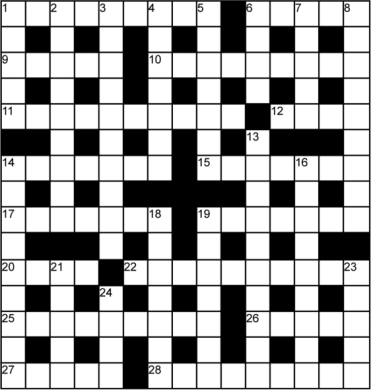
|
Across
1. Are IBM cut out to identify bug? (9) |
Down
1. Soft, soft aircraft (5) |
Prizes to the first two correct entries drawn. Closing date: 31st December 2010.
Send to:
The Editor, Hop Press, 1 Surbiton Road, Eastleigh, Hants. SO50 4HY
Issue 68 (June 2010) Solution & Winners
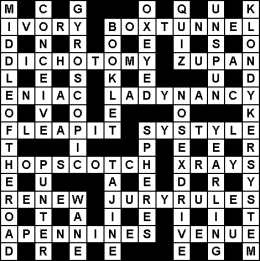
Despite the catastrophic printing/proof reading errors that missed two lines off the grid and then scrambled the clues, the response to this alphabetic puzzle was most heartening with seventeen entries, only one disallowed for a single error. Although most solvers availed themselves of the correct version available on-line at least two reconstructed the original puzzle from scratch!
Winners:
Mrs Kate Chessman, Southampton
Nigel Cook, St. Denys, Southampton
| The other fourteen correct solutions were from: | |
| Mike Barratt | Myk Cromie |
| Trevor Crowther | Philip Doughty |
| John Green | Barry Hall |
| Stephen Harvey | Gary Morse |
| Tim Parkinson | Nigel Parsons |
| Ron Poole | Harvey Saunders |
| John True | John Yalden |
Woolston Beer Festival Hop Press index
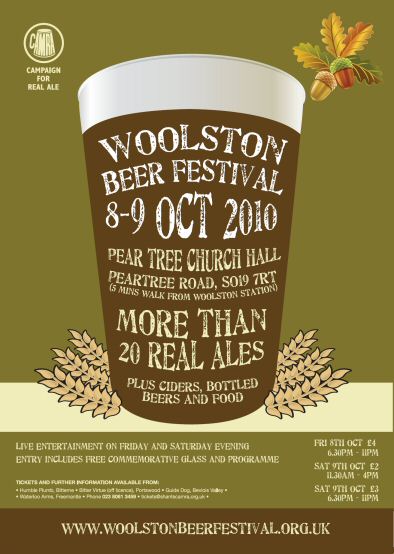 The print
version of Hop Press has a full page advert for Woolston Beer Festival. However, here we can take the luxury of
directing you to the Woolston Beer Festival website
instead.
The print
version of Hop Press has a full page advert for Woolston Beer Festival. However, here we can take the luxury of
directing you to the Woolston Beer Festival website
instead.
As Hop Press went to print, tickets were selling very well, and by the time you read this it's almost certain that all tickets will have sold out – a week and a half beforehand, only Saturday lunchtime tickets remained.
This is the first autumn beer festival that Southern Hampshire Branch has run since Eastleigh 2004 – the last time the Nightingale Centre was available to us – and is due to the efforts our newer members have put in to finding a new venue. Also on the cards is a revival of Winchester Beer Festival. If you'd like to help to ensure this happens then look on our diary page and get along to a Winchester Beer Festival Planning Meeting and lend a hand.
Southampton Beer Festival will return as it has done for the last 14 years and will be on 2nd, 3rd & 4th
June.
Walking and Drinking (11) Hop Press index
Linwood to North Gorley – (download pdf file for printing 585kB)
Ray Massey
The first walk I wrote for Hop Press, five years ago, was in the New Forest – a very easy gravel track walk from, and returning to, the Royal Oak at Fritham (then, as now, a Good Beer Guide entry). For this more difficult walk I return to the Forest, not that far from Fritham, and involving another pub of the same name. This walk is between two other Good Beer Guide pubs, the Red Shoot Inn at Linwood, going across Ibsley Common to the Royal Oak at North Gorley, and then returning.
A mild note of caution: this part of the New Forest is about as remote as Hampshire gets, so expect the navigation to be more tricky than usual. Just enjoy the challenge and the walk.
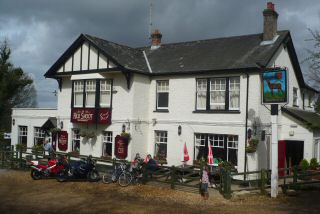
Leaving the Red Shoot Inn, walk down the narrow lane (Toms Lane) outside until you come to a sharp right bend. Note: there is very limited car parking here at the side of the lane. Cross over a stile at the bend onto a grassy path between wooden rail fences. Continue through a V-gate in a fence and over a stream onto the open moorland beyond This stream, known variously as Dockens Water or Linwood Bog, is very marshy for most of its almost straight route from near Fritham to the Avon Valley. You are fortunate here; this is one of the very few bridged crossings.
Once on the moorland (Great Bottom) go straight ahead on a small path, soon to cross helpful duck-boarding (DB on
the map) over some marsh. Unfortunately the wooden walk is too short: there are always patches of marsh at both
ends. In the driest of weather these are just about crossable in walking shoes, otherwise boots or wellies are
required.
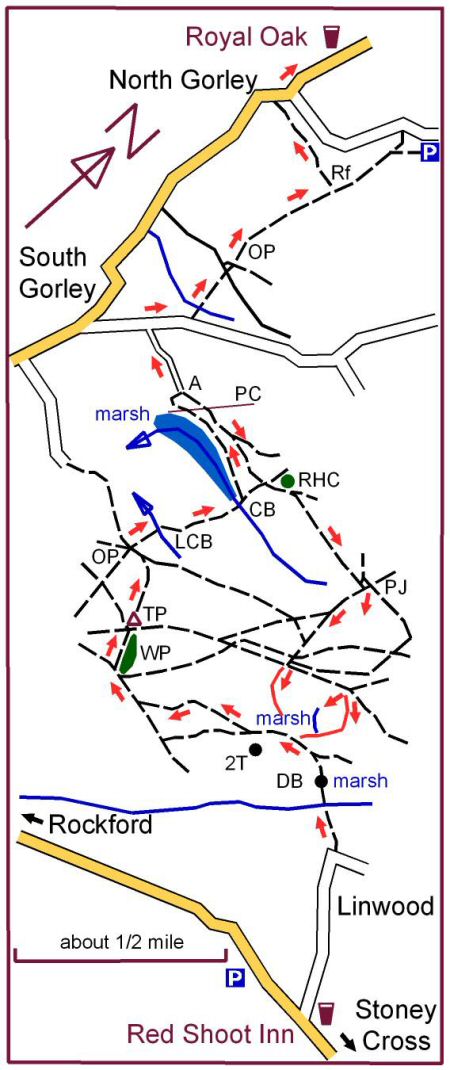
Head slightly left of the main valley in the hillside ahead. The small but easy to follow path soon curves left, to merge with a larger path coming in from the right. Continue uphill on this good path. As the climb eases two isolated trees (2T) can be seen on the skyline, and soon you reach the crest of a hill near these trees. As you begin to descend, take a right fork along a small path, aiming for a distinct line of trees (Whitefield Plantation: WP). The plantation was an experimental planting of Scots Pine; it now forms a very useful landmark on the otherwise empty plain that is Ibsley Common. The small path descends and climbs, and soon the plantation is visible again. Eventually you meet and turn right onto a large path that leads to the left end of the plantation.
Go around the plantation, and walk the length of the wood with the trees on your right. At the far end cross a large path to the white trig point (TP) ahead. Continue on a small path towards a couple of distant local power cable posts (PC). The path bends left, joining a larger path going left. Soon turn right at a path junction just before the corner of an old gravel pit (OP). The path curves, goes steeply downhill into Little Chibden Bottom (LCB), climbs, and drops even more steeply into the large valley that is Chibden Bottom (CB).
After crossing the small stream or marsh in the valley bottom, turn left along a small path just above the broadening marsh. The local power cables (PC) are visible ahead again. Climb gently, with the marsh curving away on your left, and pass under the power cables. Climb more steeply to a ridge, and bend right across a grassy area towards a fence. Turn right by the fence, going downhill. The path soon curves left and joins another (point A) to form a rough track downhill between fences. Bear left onto a gravel road that soon leads to the tarmacked South Gorley to Furze Hill road. Turn right along this quiet road, and then turn left at a footpath sign, to go across a field to a concrete bridge over a small stream (Huckles Brook). Cross a second field on a small path between barbed wire fences to another skeletal stile. Climb steadily between fences to a third stile and cross a gravel road beyond. Continue straight ahead, and immediately cross a drive and a path. Then climb steeply through light woodland to reach a plateau (Gorley Hill), and the corner of a large grassy path with a very large old shallow gravel pit beyond (OP).
Continue straight ahead, keeping as high as possible, with the old pit on your right, and the land falling steeply on your left. Look out for the roofs of houses on the left (Rf); drop down towards them and go steeply downhill with a field on your left and houses on your right. Continue steeply downhill on an old rough shady track. This track looks like it could get very muddy in winter, see later for an alternative. After a short scramble over some farming debris the track joins a much better house drive and immediately joins a tarmac road at North Gorley. Look right for the welcoming sign of the Royal Oak in the distance.
Should you miss the house roofs, don’t worry, just continue, still keeping as high as possible with the land falling steeply on your left and the pit always on your right. Eventually you will either come to a small lane or a small car park. Go through the car park and along its access track to the small lane. Do not be tempted to use the route opposite, shown by green circles on the OS map. Although it leads directly to the pub, the second part of this old byway is little more than a wet marsh. Instead turn left, downhill along the small lane, bend right, join the larger road, and look right for the Royal Oak sign. For the return journey, there are several options. Firstly, you can retrace you steps exactly, or you can use the end of the route out that you didn’t use going. When you get back to point A, you have a chance to be adventurous. Consider continuing straight ahead steeply uphill, and follow the return route shown on the sketch map.
This route keeps high above Chibden Bottom, with fine views down into the valley on your right. Soon you will pass Robin Hood’s Clump (RHC), a small copse of pines covering an obvious disc barrow. Keep on the main path just above the valley, eventually reaching a complex path junction (PJ). Turn right here, either along the large marked path, or half right to strike out across the heath. The sketch map shows 3 possible routes down across Great Bottom: 2 vague paths shown in red, and a third indication to find the head of a very distinct marsh and follow it downhill. Whichever route you choose, there should be no real difficulty in identifying the outward leg route below you, and returning to it. When the walk is complete, I hope the beer is an adequate reward.
Although a Wadworth tied house, the Red Shoot of course also has its own pub brewery, a 2.5 barrel plant, the
only brewery within the original historical boundary of the New Forest (the town of Ringwood is
outside).
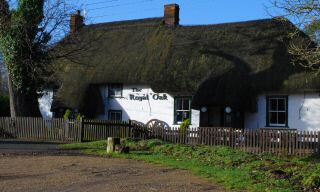
Maps: The OS 1:25,000 are the best maps for walkers. The relevant map for this walk is Explorer OL22 (New Forest). Be aware though that this OS map does contain errors in the area of Great Bottom. Unusually, it shows extra footpaths in this part of the New Forest in green. I think this is a relic from when this land was privately owned. Some of these paths do not exist now; I believe my sketch map to be better in the Great Bottom area.
Seasons: Being a predominantly open exposed area, this is really a walk for any time, except in hot sun or very cold or rainy weather. Autumn is always a good time in the Forest: late October is usually best, but with this dry summer, autumn may be early this year. This autumn might be the best time for years, because the marshes should be at their driest.
Times: Each half of the walk is about 3½ miles, so allow about 1½ hours each way for the walking part.
Transport: There is no public transport to the Red Shoot Inn, but the Royal Oak is close to the X3 Ringwood – Fordingbridge bus route.
Car Parking: Both pubs have somewhat limited car parks. Please get permission before leaving
your car there. There is also a Forestry Commission car park in Appleslade Inclosure, just down the main road
from the Red Shoot Inn. Also there is very limited roadside parking just after the start of the walk.
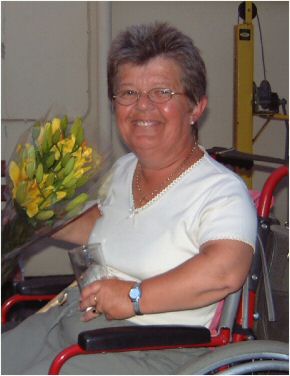
August was a sad month for the Southern Hampshire branch of CAMRA for it brought the death of one of our long-serving members, Hilary Jazuk.
A local Southampton girl, Hilary was born in 1946, the third in a family of four sisters. Although notably small in stature she made up for this with her ebullience. She was an early choice as the branch’s social secretary and later on took the office of chair. A serious stroke, with five months in hospital, confined Hilary to a wheelchair for the last years of her life but this seemed to matter little to her. With husband Mick they were frequently seen at local beer festivals and she continued as one of the distributers of this newsletter.
Attendance at the funeral, on August 23rd, overflowed the hall of the Southampton crematorium and later
completely filled the Guide Dog in Bevois Valley for a wake she would have certainly relished.
Hop Press Issue number 69. October 2010
Editor: Pat O'Neill
1 Surbiton Road
Eastleigh
Hants.
SO50 4HY
023 8064 2246
hop-press@shantscamra.org.uk
© CAMRA Ltd. 2010


|
© 2025 CAMRA Ltd. All rights reserved. Campaign for Real Ale, Southern Hampshire Branch Pages supplied by & updated by the Webmaster: Pete Horn [View Site Disclaimer, Personal Data Handing, and Cookie information] [Site History] |